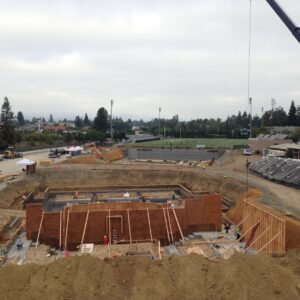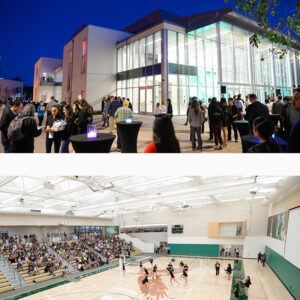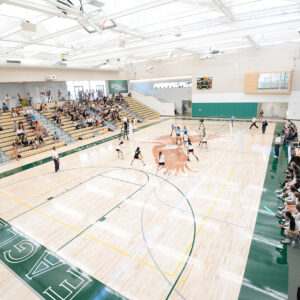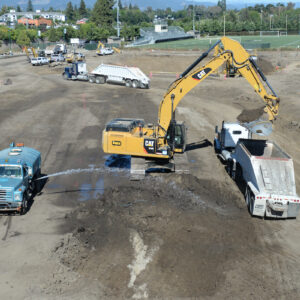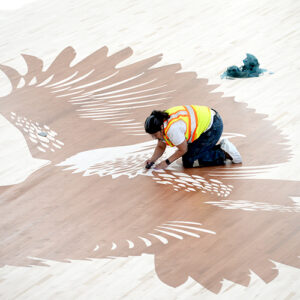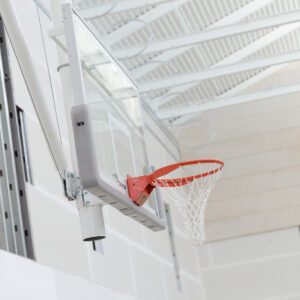The powerful ironwork structure of the performing arts (PA) center is reaching for the sky – the great frame can be seen from Harker’s middle school parking lot a mile away. The athletic center is farther along: its steel structure is rapidly being covered up. Here is a little insight into how all that steel – 575 tons for the PA center and 225 for the athletic center – moves from the steel shop to being bolted into place at Harker.
Neither building is a simple box structure, and the performing arts center is especially complex, noted the Devcon Construction managers. Just to order and refine steel needs, Kyle Olugbode, the project’s field engineer, handled more than 500 requests for information (RFIs) and submittals on the various items, exchanging scores of emails with the architect on steel alone, mostly due to the complexity of the PA center design.
Along with Olugbode on “Team Devcon” are Matt McKinley, a project engineer; Barth Nelson, the on-site superintendent who runs the field and manages the overall project schedule; and Cameron Page, the project manager who works hand-in-hand with Nelson on the schedule, project budget, etc. All the managers work to get steel shop drawings approved, help deal with RFIs and building information modeling coordination, as well as the myriad other tasks necessary to build complex structures.
The path of a girder, from manufacture to mounting, is complex. About 85 percent of the steel is from the U.S., the Devcon team said, with the remaining 15 percent mostly from Korea. All the girders used in the Harker structures are from suppliers’ stock-on-hand, as opposed to specially ordered sections.
The material itself, for the wide flange beams and columns, is a carbon steel alloy called grade ASTM A992. Uncut girders are shipped first to Concord Iron Works, a local steel shop, currently featuring a lot of photos of the Harker projects on their website.
Virtually all the steel is in I-beam configuration, with some trusses (flat connector pieces). At the CIW shop, the uncut girders are shaped into a variety of configurations, including wide flange (W) beams and columns, HSS (tube) columns and truss members. Other parts are channels and angled sections.
CIW preps beams to the architect’s specifications, cut and drilled with computer number controlled (CNC) machinery to 1/16-inch tolerance – the clearance for the bolt holes to match up – so each section is ready to bolt up when it leaves the shop. When a rare trimming is required, it is usually when fitting members to connections cast into the concrete foundations or retaining walls, Team Devcon noted.
The sections are then sent to Harker in primer on 40-foot trailers, and that’s when the action really gets going. Sections are off-loaded with fork trucks and staged where workers from CIW and O’Brien Steel Erectors of Stockton can hook up and swing the beams up to workers.
Anyone observing the site can’t help but marvel as girders, from a few feet long to a massive 73-foot girder in the athletic center, sway gracefully into place, guided the last few feet by steel workers. Erecting steel structures is a particular skill for crane operators, said Team Devcon. Harker’s crane workers, an operator and an oiler, are specialists from Bragg Crane & Rigging Co.
Once the girders are in the air, workers from O’Brien Steel take over. Steelworkers typically serve a four-year apprenticeship to learn how to handle the steel, then go on to train in welding if desired, said Team Devcon. For the Harker buildings, beams are bolted into place, with some receiving additional welding using flux core arc welding (FCAW) NR232. This process uses a continuous wire electrode with a flux core to create a powerful bond between sections.
If welds are concealed within the building envelope, touch-up primer is sometimes applied, but little to no corrosion occurs on inside welds. Exterior, exposed welds receive rust resistant priming, said Team Devcon.
For each building, all steel exposed to the weather is required to be hot dip galvanized. This is a zinc coating applied to the steel following fabrication and before it arrives at the site.
Wherever welds are made to the galvanized steel, the coating in the welded area must be replaced with a zinc-rich spray primer. If required by the project, galvanized steel can receive a painted finish. However, the galvanized coating can stand alone without a topcoat.
Once steel is bolted or welded into place, workers will cloak the frame in the upholstery of interior finishings. Hidden, the steel of both buildings will provide the wonderful physical structure for Harker athletes, performers and the community in general, just as Harker faculty and staff will provide the intellectual structure, to aid Harker students as they progress through the school.
Check out the latest construction update video!
Beginning in June 2016 Harker launched two new state-of-the art building projects on the upper school campus, the result of a $45M capital campaign. The 33,000 square-foot athletic center, opening August 2017, features a 12,000 sq.-ft. gym, athletic training room with advanced hydrotherapy unit, and spacious team rooms. The Rothschild Performing Arts Center, opening spring of 2018, features a 450-seat theater with fly loft and hydraulic orchestra pit, a state of the art scene shop, vocal, instrumental, theater/musical theater classrooms and dressing rooms. For more information visit the news and video links below or contact communications@harker.org
Theater and Gym Project Videos
Articles
Construction Starts with Demolition and Cleanup – Short Video
Groundbreaking for Athletics and Performing Arts Complex on Track for Spring 2016
Harker Breaks Ground on New Theater and Gym
Harker Takes Historic First Step at Groundbreaking Ceremony
Athletic and Performing Arts Centers Construction Starts in Earnest
Rising Walls of PA and Athletic Centers Excite Students, Bring Maturity to Campus
Steel in the sky: performing arts and athletic centers’ strength on display
Athletic center interior components tailored to function throughout
Final athletic center amenities going in, grand opening coming Aug. 18






